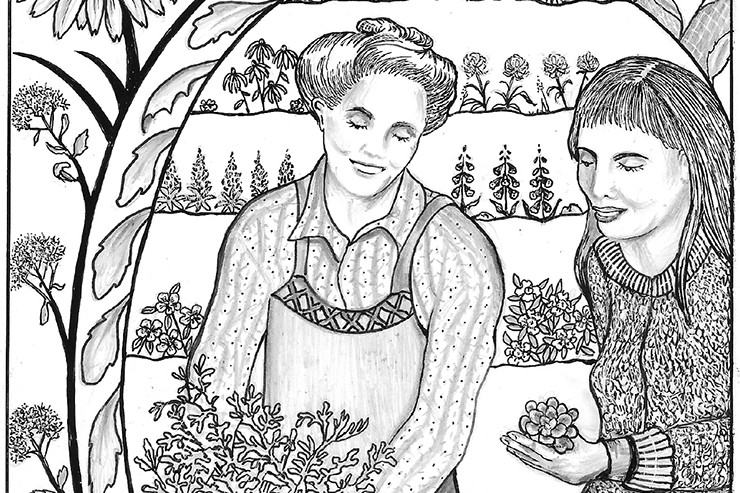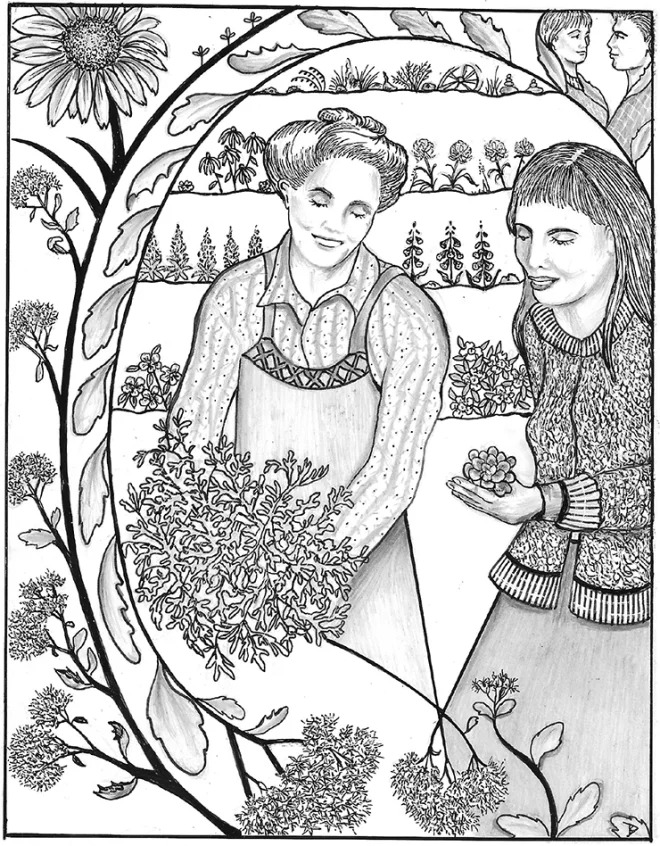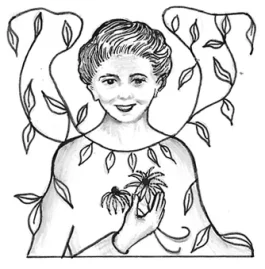
Do you remember when you were learning to garden; the first time you planted a seed and, following all the signs of nature, brought it to bloom? Gazing at your vibrant garden gives you a sense of satisfaction like nothing else—it’s why flower gardening is one of life’s joys. But before you can revel in success, there are plenty of factors to consider: soil conditions, light levels, water requirements—the list goes on and on.
That’s why it’s nice when to have a gardening mentor. Someone who can show you the ropes and give advice. Someone who has made enough mistakes for the both of you!
Jackie Hostetler, the author of today’s story, “Live Forevers” had limited experience with gardening until she met her future husband, Ryan. After visiting his family home and seeing how much he loved his mother’s garden, Jackie was determined to get serious about gardening. After getting married and settling into a new home, she decided to learn more about gardening with help from Ryan’s mother who provided advice on how to design gardens and use plants. Despite following her instructions closely, the pressure of keeping everything going is too much for Jackie until she discovers a plant that says it lives forever and is easy to care for.
With newfound confidence in her green thumb, Jackie goes on to create a whole new garden, making it truly hers rather than just replicating what was there before. The success of this endeavor brings joy not only through seeing beautiful blooms but also being able to share it with her husband. Keep reading for the whole story.
Enjoy More Stories about Learning to Garden
This story comes from our archive that spans over 30 years, and includes more than 130 magazine issues of GreenPrints. Pieces like these that turn stories of the joy of gardening into everyday life lessons always brighten up my day, and I hope this story does for you as well. Enjoy!

Live Forevers
The plant that set me free.
By Jackie Hostetler

My experiences with gardening in my youth were scant, to say the least. My mother had a bed of hostas outside my childhood home. Once when I was 17, my parents went on a vacation to Arizona. They left me home to keep doing my Summer job as a lifeguard. It was my responsibility to water the hostas while my mother was away. I did. Twice.
I didn’t garden in college or when I started my career as a teacher. I didn’t even have a houseplant. Then at the age of 27, I met Ryan, my future husband.
He was a transplant to my home town of Kansas City from a small town in Nebraska. Before we were engaged, I made the pilgrim-age to Nebraska to meet his family.
Ryan was excited to introduce me to his family hometown. Quite uncharacteristic of the young men I’d known before, he went on and on about his mother’s gardens. He spoke of how beautiful they were and reminisced about memories of his mother working in the garden. He explained the family tradition of collecting rocks from their travels to display among the plants and flowers.
When we arrived, I saw for myself that the gardens were indeed beautiful. My future mother-in-law gave us a walking tour, casually deadheading the black-eyed Susans, picking blooms off the begonias, and pointing out her stones, state by state. I observed my boyfriend beaming. This was something special to him. As a girl eager to make a life with the man I loved, I took note.
Ryan and I were married within a year. Over the next Winter, we purchased our first real home. I decided I needed to get serious about this gardening business. I started small that Summer, with a few potted plants on the porch. The plants, leggy and barren, barely survived the baking Summer.
I was not discouraged. I was determined to try again the next Summer. But the following Spring, I was busy growing something else. I spent the next four gardening seasons either pregnant or nursing a little one. Taking care of my two baby boys left little time or energy for anything else. Gardening? Someday.
As time passed, we moved from our small city lot to a perfect country home far outside of Kansas City. We had plenty of space, and the boys were now old enough to toddle with me outdoors.
No more excuses. This would be the season I really and truly made a garden. I was so serious about this endeavor that I enlisted the help of my mother-in-law. She stayed with us for a week in early Summer. During that time, we plotted out gardens, installed borders, laid landscaping fabric, mulched, and spent a small fortune on plants and flowers.
She instinctively knew where and what to plant. She came up with dazzling combinations and creative arrangements. She rattled off tips and tricks, which almost sounded like a foreign language to me. Per her advice, we went almost solely with perennials. She advised that they were less expensive and more abundant in the long run. We did purchase a few annuals, and she showed me how to use them as fill and accents. The gardens looked gorgeous.
And then she left.
That first Summer I felt moments of true panic. We had sunk several hundred dollars into these gardens. It was up to me to keep everything going. If I let them die, it would be like tossing money down the drain. The pressure kept me from truly enjoying the hobby. I welcomed the first frost in October. Any plants that died now were Mother Nature’s fault, not mine. Phew.
I didn’t give much thought to my plants until early Spring. Then, like a tiny green miracle, emerald crowns began to poke up through the soil.
I tended my gardens the next Spring and Summer just as my mother-in-law had instructed. I didn’t divert from her directions for a second. If a plant didn’t make it, I replaced it with the exact same one. I set the antique wagon wheel in just the spot we had picked together a year earlier. I didn’t add anything. I didn’t take anything away. Everything was exactly the same, down to the color of the impatiens in my hanging baskets. I was stuck on the thought that if I did it differently, I was doing it wrong. My mentor had never sent this message, but I didn’t have the confidence or knowledge to experiment. This again sucked all of the fun out of gardening for me. It was stressful, not satisfying.
As before, I welcomed freezing temperatures. Also as before, Spring sunshine brought forth tiny green crowns. Oof, here we go again.
That May, a coworker brought a trash bag full of sprouts to work. She reported that her live forevers (sedums) had overtaken her garden, and she was doing some pruning. She brought them for anyone who might be interested. I was immediately drawn to the name. Live forever? That sounded like something even I could keep alive. But where would I put them? My mother-in-law never mentioned live forevers. Was it OK for me to plant some?
My coworker, also a seasoned gardener, explained that they were easy to care for, hardy, and thrived anywhere. She encouraged me to take a few and just plant them somewhere. A little reluctantly, I did—placing them along a cement ledge by our garage. I had never discussed this place with my mother-in-law. But even without her guidance, they grew! They grew beautifully, thick and dark green, with delicate blossoms in the early Autumn.
I had done it.
As my coworker predicted, the sedum became quite voluminous over the next season or two, necessitating the need for some thinning. What to do with the discarded sprouts? I planted them elsewhere, encroaching upon my previously unchanged flower beds. The additional plants brought a new vibrancy to the garden. They brought a new vibrancy to me. I added Shasta daisies. I took away the daylilies. I moved the wagon wheel. The gardens were becoming my own—and I was becoming a gardener.

It’s been many Summers since my mother-in-law started me on my botanical journey. I am forever grateful for the gift, and I still turn to her regularly for advice. I like it when she is proud of my work. I like it even more when I catch Ryan surveying our gardens. I see the same look in his eye that I saw the Summer we first traveled together to Nebraska. I have the look now, too.
I think it is love. ❖
By Jackie Hostetler, published originally in 2020-21, in GreenPrints Issue #124. Illustrated by Blanche Derby

Does this story remind you of one of your own from when you were learning to garden? Leave a comment and share it with us!




Beautiful, beautiful! My precious and much missed Daddy taught me about that first seed planting. As I grew older, he and I worked side by side in our small gardens. In Hawaii, everything grew! My first experience in growing okra because my husband was from the South turned out to be a real hoot, it broke my trowel because I harvested it too late and it was like the cement carport I had laid it on to see how it would cut! I wish we could live forever with all of our loved ones and gardens!
When I was small our next door neighbor had the most beautiful Iris. I lived in Oklahoma but the iris she obtained from visiting the state of Washington. I would peek thru the fence to watch her tend to those pretty tender flowers. The blossoms were giants. She also had petunias. I thought she was a rich lady beings we were a family of ten people that had nothing because she had petunias. I laugh now thinking how cheep they are. I think of the rich lady when I have volunteer petunias of my own. I am a rich lady.